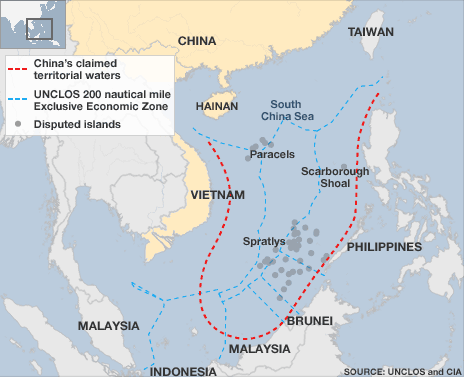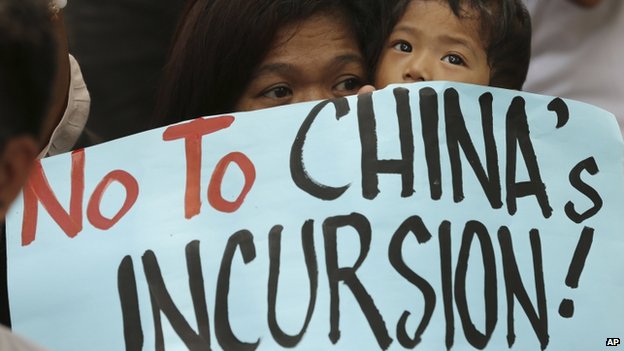Aside from Vietnam, with its greedy U-shaped or nine-dotted line that covers over 80 percent of the South China Sea (East Sea), China also has maritime disputes with the Philippines, Taiwan, Indonesia, Brunei and Malaysia. To further understand China's ambition and plot in the East Sea, VietNamNet give you a panorama of the dispute between this country and the Philippines.
China’s territorial claims

China claims to have discovered the islands in the Han Dynasty in 2 BC. The islands were claimed to have been marked on maps compiled during the time of Eastern Han dynasty and Eastern Wu (one of the Three Kingdoms).
Since the Yuan dynasty in the 12th century, several islands that may be the Spratlys have been labeled as Chinese territory, followed by the Ming Dynasty and the Qing dynasty from the 13th to 19th Century. In 1755, archaeological surveys the remains of Chinese pottery and coins have been found in the islands and are cited as proof for the PRC claim.
Chinese fishermen have used the islands since 200 BC.
China claims by far the largest portion of territory - an area defined by the "nine-dash line" which stretches hundreds of miles south and east from its most southerly province of Hainan. It says its right to the area comes from 2,000 years of history where the Paracel and Spratly island chains were regarded as integral parts of the Chinese nation.
In 1947 China issued a map detailing its claims. It showed the two island groups falling entirely within its territory.
The Philippines’ territorial claims:
The Philippines affirmed there was no effective sovereignty over the islands until the 1930s when France and then Japan acquired the islands. When Japan renounced their sovereignty over the islands according to the San Francisco Treaty, there was a relinquishment of the right to the islands without any special beneficiary.
In 1956, a Filipino citizen, Tomas Cloma, unilaterally declared a state on 53 features in the South China Sea, calling it "Freedomland". As the Republic of China moved to occupy the main island, Cloma sold his claim to the Philippine government, which annexed the islands in 1978, calling them Kalayaan. On June 11, 1978, President Ferdinand Marcos of the Philippines issued Presidential decree No. 1596, declaring the Spratly Islands as a part of Filipino territory.
Both the Philippines and China lay claim to the Scarborough Shoal (known as Huangyan Island in China) - a little more than 100 miles (160km) from the Philippines and 500 miles from China.
Rival countries have wrangled over territory in the South China Sea for centuries - but a recent upsurge in tension has sparked concern that the area is becoming a flashpoint with global consequences.
Recent actions:
In 1970, China occupies Amphitrite Group of the Paracel Islands.
In 1971, Philippines announces claim to islands adjacent to its territory in the Spratleys, which they named Kalayaan. The Philippines President Marcos announced the claims after Taiwanese troops attacked and shot at a Philippine fishing boat on Itu Aba.
In February 1992, China passes a law declaring the entire South China Sea as its territory, triggering protests from around the region.
In 1997, the Philippines begins to challenge Chinese sovereignty over the Scarborough Shoal.
In 2002, ASEAN and China agree to a code of conduct in the Declaration on the Conduct of Parties in the South China Sea.
On February 25, 2011, the Chinese frigate Dongguan fired three shots at Philippine fishing boats in the vicinity of Jackson atoll. The shots were fired after the frigate instructed the fishing boats to leave, and one of those boats experienced trouble removing its anchor.
In April 2012, the Philippine warship Gregorio del Pilar was involved in a standoff with two Chinese surveillance vessels in the Scarborough Shoal, an area claimed by both nations.
The Philippine navy tried to arrest Chinese fishermen who were allegedly taking government-protected marine species from the area, but the surveillance boats prevented them.
On April 16, 2012, the Chinese Foreign Ministry urged a Philippine archaeological ship to immediately leave the waters of the Scarborough Shoal, which China claims is an "integral part of its territory."
On May 7, 2012, Chinese Vice Foreign Minister Fu Ying called a meeting with Alex Chua, Charge D'affaires of the Philippine Embassy in China, to make a serious representation over the current incident at the Scarborough Shoal.
China then raised trade barriers on imported pineapples and bananas from the Philippines. On May 16, 2012, a fishing ban in the Scarborough Shoal by the governments of China and the Philippines became effective.
By July 2012, China had erected a barrier to the entrance of the shoal.
On September 5, 2012, Filipino President Aquino promulgated Administrative Order No. 29, naming maritime areas on the western side of the Philippine archipelago as the West Philippine Sea.
On September 23, China launched a program to increase the number of UAVs monitoring the Scarborough Shoal, Paracel Islands, Spratly Islands.
On January 10, 2014, China imposes a "fishing permit" rule in the South China Sea, much to the chagrin of the United States, the Philippines, and Vietnam.
On March 11, 2014, two Philippine ships are expelled by the Chinese Coast Guard from Ayungin Shoal in the Spratlys Islands.
In January 30, 2013, Filipino officials took their territorial disputes with China to international arbitration after Chinese government ships took control of a disputed shoal off the northwestern Philippines.
On March 30, 2014, the Philippines submit its legal arguments and evidence on the case.
Agreements:
China and the 10-member Association of South East Asian Nations (ASEAN), including the Philippines, signed an agreement in 2002 to refrain from occupying uninhabited reefs and shoals in the sea, and from building new structures that would complicate disputes.
The DECLARATION ON THE CONDUCT OF PARTIES IN THE SOUTH CHINA SEA (DOC) says the parties reaffirm their commitment to the purposes and principles of the Charter of the United Nations, the 1982 UN Convention on the Law of the Sea, the Treaty of Amity and Cooperation in Southeast Asia, the Five Principles of Peaceful Coexistence, and other universally recognized principles of international law which shall serve as the basic norms governing state-to-state relations;
The parties plan to set up a formal code of conduct (COC) to resolve the dispute and prevent any potential conflict. But the process of negotiations has been proceedings very slowly.
Official voices from the governments:
With the Philippines’ arbitration bid progressing before the United Nations, China blasted Manila for its legal recourse to settle maritime disputes in the South China Sea, and accused the Philippines of deviating from the agreed upon guidelines of discipline, as well as provoking tensions in the disputed waters.
In strongly worded remarks, Chinese Foreign Ministry spokesperson Hua Chunying scored the Philippines for its “indifference” to China’s position and charged Manila with discrediting Beijing before the international community, reported The Inquirer.
The Philippines on February 25, 2014 strongly protested China’s water cannon attack on Filipino fishermen in a disputed shoal nearly a month ago, citing how such acts “escalate tensions” and “threaten the peace” in the region.
Lt. Col. Ramon Zagala, spokesman of the Armed Forces of the Philippines, told reporters that while the Chinese action was “alarming,” it did not warrant an immediate military response.
The Philippine government on May 14, 2014 released military surveillance photos of Chinese land reclamation on a reef claimed by Manila in the South China Sea that it said showed Beijing violated a regional agreement not to escalate territorial disputes, reported CBC News.
Foreign Affairs Department spokesman Charles Jose said the pictures show Chinese aggressiveness in asserting its claims over the entire South China Sea.
The aerial photographs were accompanied by a caption stating that they were obtained from "Philippine intelligence sources." The caption said the "extensive reclamation" by China on the Johnson South Reef, called Mabini by Manila and Chigua by Beijing, was "destabilizing.
The Philippines on February 27, 2014 called on Malaysia, Vietnam and other claimants to join its legal challenge to China's massive territorial claim in the South China Sea, reported AP.
The Philippines chief lawyer, Solicitor-General Francis Jardeleza, said Malaysia, Vietnam and two other governments could either take part in the Philippine case or file their own complaints against China.
Smaller countries, he said, can only have a chance to peacefully defend their territories against the Asian superpower in a legal arena.
"Where can the weak go?" Jardeleza asked in a Manila forum on the territorial disputes. "We are here to prove that from the point of view of the rule of law, all of the actions and all of the claims of China are ... invalid."
What does international media say

The Philippines accuses China of strengthening its military presence in the South China Sea
In a resolution issued in Brussels in March 2014, the Centrist Democrat International (CDI) said it “condemns the forcible takeover and occupation of the Scarborough Islets and the Ayungin Islands in the South China Sea” that the CDI said were “possessed and occupied by the Philippines as part of its continental shelf and within its exclusive economic zone.”
The CDI is an umbrella organization of political parties and groups working with democratic governments around the world.
New York Times June 16, 2014 reported that Chinese actions have also worried senior United States officials. Defense Secretary Chuck Hagel scolded China for “land reclamation activities at multiple locations” in the South China Sea at a contentious security conference in Singapore in late May.
Critics say the islands will allow China to install better surveillance technology and resupply stations for government vessels. Some analysts say the Chinese military is eyeing a perch in the Spratlys as part of a long-term strategy of power projection across the Western Pacific.
US Secretary of State John Kerry in April 2013 conveyed Washington’s support to the Philippine Government’s decision to bring its territorial disputes with China in the South China Sea before a UN arbitration tribunal, describing Manila’s move as “a step in the right direction.”
In a statement, the Department of Foreign Affairs (DFA) said Kerry expressed the US' full support for the Philippines in aiming to seek for a peaceful resolution to the disputes over the resource-rich West Philippine Sea (South China Sea), which is being claimed by four other countries—Taiwan, Vietnam, Malaysia and Brunei Darussalam.
Kerry specifically said the US will be showing support for the Philippine initiative to form an arbitral tribunal under the United Nations Convention on the Law of the Sea (Unclos) during the Association of Southeast Asian Nations (Asean) summit and related meetings.
Filipino newspapers China keep doubtful about China’s willingness to set up a COC for the South China Sea issue.
GMA News in June 2014 commented that China will not likely work for a rapid completion of a legally binding code of conduct in the South China Sea until all its expansion activities in the resource-rich waters is completed, Foreign Affairs Secretary Albert del Rosario said on Thursday.
Del Rosario, casting doubts on China’s sincerity in agreeing to negotiations on a non-aggression pact with its Southeast Asian neighbors, said its “expansion agenda” in the South China Sea is stalling efforts to finalize a code.
“I’m not very optimistic about whether China is serious about an expeditious conclusion [of a code of conduct] because I can see the aggressive provocative acts that we are seeing now and which is, I think, is their way to pursue an expansion agenda,” Del Rosario told reporters at the sidelines of the Asia-Europe Meeting (ASEM) on disaster management in Manila.
China - which claims nearly the entirety of the South China Sea—has recently increased its construction activities and civilian and military presence in contested areas, triggering concerns among its smaller Asian neighbors that are also laying claim to some parts of the area.
http://english.vietnamnet.vn/fms/special-reports/106862/the-china-philippines-dispute-in-the-east-sea.html

No comments:
Post a Comment
Note: Only a member of this blog may post a comment.